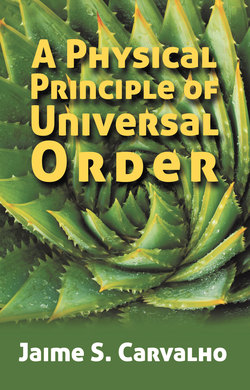Читать книгу A Physical Principle of Universal Order - Jaime S. Carvalho - Страница 7
На сайте Литреса книга снята с продажи.
The ultimate source of order
ОглавлениеOur world—stars, planets, trees, and people—is constantly changing. Stars are born and die, the earth is continuously rotating and translating, trees have cycles of growth and decay, and the same is true with us. But this change is not arbitrary: there is an order hidden in it. We know that tomorrow will be here and next spring will arrive in the predicted time. It is the existence of this order that allows us to make plans for the future. And it is because of this order that not everything is possible in the world. We cannot fly like birds do, for instance. There are laws in nature.
Logically, however, there should be just one general law from which all other partial laws should derive. If there were two or more general laws, a clash would inevitably occur at some point along the vast time expanse of evolutionary development, with disastrous consequences. Besides being the most general of all laws, that single law of order should be simple and should reside at the beginning of all things: that is, at the level of the field, since it is from the field that every structure derives. The unitary field theory referred above fits these requirements. But how did such field theory come about?
A turning point in theoretical physics occurred somewhere from the late nineteenth to the early twentieth century, when it was recognized that in isolated systems the cause and effect relation—the causal relation characterizing any science—was not equal. This scientific conclusion contradicted what Greek philosophers had assumed and present physical science had accepted—equality of cause and effect. The principle of conservation of matter and energy, one of the pillars of modern physics, is therefore based on the equality relation. Conversely, the new unitary theory is grounded on the scientific relation of cause-effect inequality. This type of causal relation is more general than, and contains within it (when the inequality is vanishingly small), the equality relation.
Such drastic change in the foundation of physics required a correspondent change in its basic conceptions. For unitary theory, unchanging matter and energy disembodied from matter—that is, outside matter—do not exist. What exists and is directly observed is structure, which is in constant change. And structure itself is conceived as a system of relations obeying certain logical properties.
The old ideas of permanent matter and flowing energy are both contained in the new idea of changing structure. Under this reasoning, energy is conceived as structural asymmetry, taken as any distortion of a latent symmetry or regularity. In other words, structure is itself a form of energy or, more specifically, structure is energy in a characteristic form. Energy and structure are thus intimately related. The changing relations of structure are very appropriate to the description of complex systems such as organisms.
Besides the concepts of matter and energy, the concepts of time and space are also changed by unitary theory. Space becomes primary and time secondary. In other words, time becomes a function of space. Furthermore, time as an entity or measured quantity is discarded from theory and replaced by the realistic, immediately observed, temporal relation of succession (later than). The irreversibility of time is thus explicitly contained in the theory. The unitary space is the three-dimensional space of our daily experience and the spatial relations of structure are those of position, orientation, rotation, translation, spin, etc. Unitary theory is a relational theory.
With the basic unitary concepts summarily defined, we can now consider the unitary field theory itself.
Fundamentally, the unitary field is thought to be made up of infinitesimally small three-dimensional particles or structures that are polarized and polarizable: that is, they possess a polar asymmetry. The field is always in process, the field structures spontaneously changing from asymmetry toward symmetry and, by the action of the field itself, back again to their initial asymmetry. But when a given structure manages to separate itself (not isolate) from the field, it loses some of its asymmetry. Stating this thought more generally: “Under isolable conditions, there is an inherent tendency in microstructure toward symmetry.” Yet total symmetry is never reached, because no structure is completely isolated from the field or isolated for too long in all respects.
Only when a structure is changing from a certain degree of asymmetry to lesser asymmetry, or more symmetry, does energy become manifested. Free energy in classical physics is structural asymmetry in unitary physics.
This single and irreversible, or one-way, process—the tendency to symmetry—is expanded from the physical field to all the four realms: preorganic, organic, psychological, and social. This universal process of change is believed to be the law of nature, which the new theory calls “unitary principle.”
The natural process of changing structure could not be simpler, but its strange and pervasive simplicity is not easily grasped by the human mind accustomed to concepts of permanence. It took over a millennium of philosophical and several centuries of scientific thought to get some insight into its operation. The problem is: how can a ceaseless transformative process be understood? How can the continuity of the universe be sustained in an apparent steady-state when everything in it is constantly changing? Surely, no arbitrariness can be allowed to exist within process. Instead, there must be some invariant within that change, some kind of inherent order. It was this evasive, almost inconceivable, natural order that was interpreted in unitary theory as a “tendency.” Tendency to symmetry corresponds to tendency to order and regularity. The universal order therefore ultimately comes from the field process.
